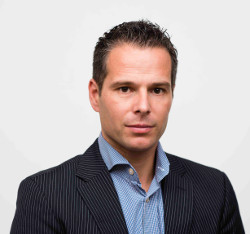It is not surprising, therefore, that the World Economic Forum, which brings the world’s leading thinkers, scientists, innovators, politicians and business people together to discuss the big issues we face, put the circular economy on its agenda. At the Annual New Champions summit in Dalian in China last September, the World Economic Forum’s Project MainStream continued to discuss key ways to drive the circular economy forward including the use of new tracking technology to enable manufacturers to monitor and manage the materials and goods for future life cycles.
At DLL, we believe that manufacturers are really at the heart of this new revolution and that their efforts to shift to circular models, as some are starting to do, represents one of the greatest innovative challenges of our times. In October, DLL launched a new whitepaper, Sustainable returns by recovering used assets, which explores the processes underpinning this change and the barriers that will need to be overcome for manufacturers to make this revolutionary shift to the circular model.
Based on our findings there are a number of important pillars supporting circular manufacturing, three of which include the service based model; the use of asset tracking technology to monitor assets; and well-organized take back and refurbishment systems. Already, manufacturers going down this path see that it generates new revenue streams. The pioneers also know that in the long run it’s a total game changer from the point of view of people, planet and profits.
In the past, manufacturers have sold assets to customers. This seemed to make most sense. But in a world where you want to minimise waste, it is far better for the producers to retain ownership, selling instead a service to the customer. For customers, this tends to mean they get a better service overall with maintenance and quality being at the heart. They get the scanning service rather than the MRI machine, for example. Manufacturers in turn can ensure they service and maintain the product and keep it in a good condition, prior to its next cycle.
The second pillar, monitoring is being brought into reality by the new technology wave of chips and sensors that will monitor things, feedback information and enable machines to talk to machines, known as the Internet of Things (IoT). Some predict 50 billion devices will be connected this way. Whatever the true figure, this new capability is driving revolutionary change among manufacturers, many of whom are already keen to use it to optimize production processes and improve customer service.
In London, recently experts in electronics and textiles met to discuss the implications of this new technology for asset tracking. The participants advocated the use of RFIDs (Radio Frequency Identification) “as a way of capturing and passing on information throughout a product’s life”, capturing information for the next stages of reuse and recycling [5]. Indeed, there is big money in monetizing waste through the circular economy fuelled by the use of digital technologies, says Accenture’s Managing Director Peter Lacy: “…harnessing data allows companies to put a value on waste in all its forms and monetize that waste through products and services that delight customers and generate significant new revenue growth. By 2050, we think as much as $25 trillion could be up for grabs.”[6]
Increasingly, manufacturers are seizing these new opportunities offered by the Internet of Things and in some cases, shifting to a more service based model in the process. A new report from Tata Consulting Services (TCS), Internet of Things [7], found that 79% of organizations are using internet-connected technologies to track their customers, products, the premises in which they do business with customers or their supply chains. Of all the sectors using this new technology, manufacturers, dubbed the “rock stars of IoT”[8] claimed the biggest income boost from applying it, averaging a 28.5% revenue increase.
The report also found that 15.4% of companies using IoT technology were shifting to the ‘product-as-a-service’ model based on the greater leasing of products. They predicted this would climb to 19% by 2020. Sysmex, for example, moved from selling its blood analyzing equipment to selling a service instead. “Its customers get paid a set amount by an insurance company to do a blood test. The expense side of the equation is unpredictable for the labs: Equipment might break, or the U.S. Food and Drug Administration may add requirements. With a service model, Sysmex eliminates the uncertainty. It takes care of the maintenance and equipment, while the lab pays Sysmex a set fee for each reportable result to insurers.”[9]
The third pillar is about developing processes and systems for taking back and refurbishing goods for a second life cycle. Here, the tracking technology could revolutionize manufacturer’s ability to do this. They need to understand the material flows of their products, so that they can plan and facilitate the next cycle.
All three pillars: the service based model, monitoring assets and take back connect together, fuelled by new digital technology and new financing models, are driving forward this great innovation: the circular economy for manufacturers.
To get a copy of the latest DLL whitepaper ‘Sustainable returns by recovering used assets’, published in October, please visit our website
[1] http://www.theguardian.com/sustainable-business/2015/aug/26/how-the-circular-economy-is-taking-off-in-the-us
[2] Ken Webster, The Circular Economy: A Wealth of Flows, Ellen MacArthur Foundation Publishing, 2015, p. 81.
[3] The Circular Economy and Benefits for Society Swedish Case Study Shows Jobs and Climate as Clear Winners, The Club of Rome, April 2015.
[4] Ken Webster, The Circular Economy: A Wealth of Flows, Ellen MacArthur Foundation Publishing, 2015, p. 81.
[5] http://www.greatrecovery.org.uk/resources/tracking-tracing-materials-in-the-circular-economy/
[6] https://agenda.weforum.org/2015/08/why-the-circular-economy-is-a-digital-revolution/
[7] Tata Consulting Services, Internet of Things: The Complete Reimaginative Force, TCS Global Trend Study, July 2015.
[8] Tata Consulting Services, Internet of Things: The Complete Reimaginative Force, TCS Global Trend Study, July 2015, p. 93.
[9] Tata Consulting Services, Internet of Things: The Complete Reimaginative Force, TCS Global Trend Study, July 2015, p. 171.

